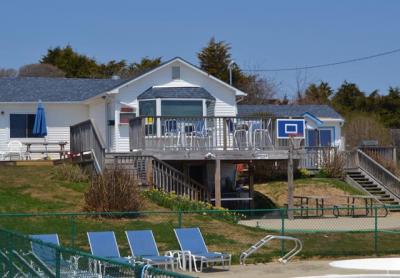Guild Hall's Honorees Included One of Their Own
Guild Hall's Honorees Included One of Their Own

In a surprise twist at the annual Guild Hall Academy of the Arts dinner at the Rainbow Room in Manhattan on Tuesday night, a person not on the roster of honorees became the evening's most notable lifetime achievement award recipient.
Mary Heilmann, A.M. Homes, and Charlotte Moss and Barry S. Friedberg had all received their awards when Sarah Jessica Parker took the podium to accept hers. After a witty tribute by Eric Fischl, the president of the Academy of the Arts, she began by acknowledging how important Guild Hall and its programs were to her and the community, but her remarks quickly pivoted to focus on Ruth Appelhof, Guild Hall's longtime director who announced her imminent retirement last year.
A video tribute to the outgoing director was cued, citing 17 years of achievement in programming and the restoration of the building, as well as highlighting Guild Hall's new artists in residence program, which is expected to be one of her legacies. Ms. Parker continued after the video, suggesting that Ms. Appelhof be named "permanent cultural ambassador for life" and sharing a tribute to Ms. Appelhof that she worked on with Jon Robin Baitz, the playwright and screenwriter.
In particular, the actress cited Ms. Appelhof's efforts in "tirelessly, tirelessly working to keep our beautiful place also culturally beautiful," especially in the summer "when we all hide like mice from a tribe of feral cats and feel like it's endangered of losing some of its magic."
Ms. Appelhof's stunned surprise at the award, and the standing ovation that followed, was undoubtedly genuine. "Oh my goodness," she said, before asking the audience to acknowledge Guild Hall's staff and board. Without having any prepared remarks, she thanked the board and academy and promised to continue to support the institution and community in her retirement.
The first group of five artists in residence, who are now living in Guild House, a residence behind the cultural center, which was acquired last year, were at the dinner. This was fitting, as the initiative came out of an acceptance speech that Mr. Baitz gave upon receiving his lifetime achievement award a few years ago.
Basically a call to arms to make certain that the next generation of artists, actors, and writers are nurtured by the community, it was a mandate that Ms. Appelhof and Mr. Fischl took to heart and began working on. Having the first group of artists in residence on Tuesday, during what is likely to be Ms. Appelhof's last academy dinner as director, was clearly a proud moment for her, which she also acknowledged.
Ms. Heilmann's award in visual arts was presented by Adam Weinberg, the director of the Whitney Museum of American Art. Roseanne Cash presented A.M. Homes's literary arts award. Howard Milstein, a longtime business partner of Mr. Friedberg, presented the philanthropic award to Mr. Friedberg and Ms. Moss.







